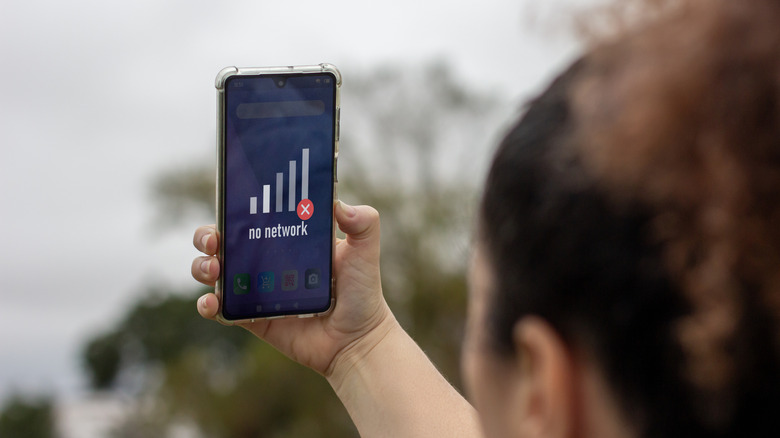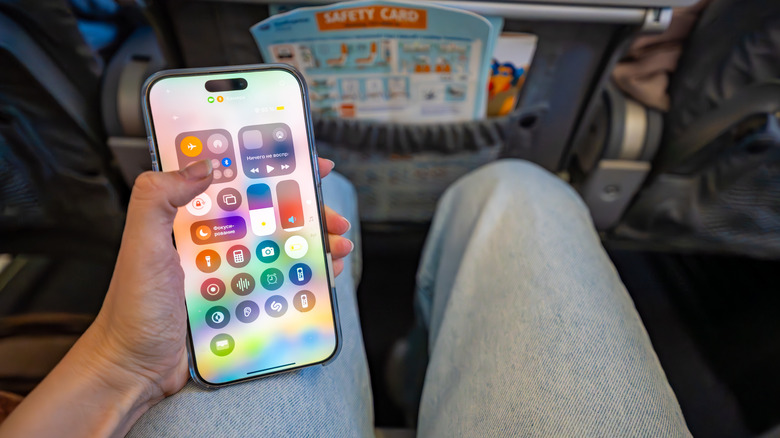How To Fix A Bad Phone Signal In Just A Couple Minutes
If there were a single, signature issue of living in the modern age, it's contending with a lousy smartphone signal. There are few things as existentially frustrating as trying to make a call or look something up and being stopped dead by having no bars, even with a wireless unlimited data plan. The good news is that since this problem has become so commonplace, tech-savvy mobile users have cooked up ways of remedying it quickly and decisively, whether by tinkering with the phone's software or changing its physical condition.
While it would be best if your signal didn't drop off at all, there is a proverbial bag of tricks you can try when your connectivity is lacking that can get things back on track. These solutions are noninvasive and won't endanger your phone's general functionality. After all, the last thing you'd want is to break your phone entirely while trying to fix a weak signal.
Getting your phone in the right condition can help
Before you start messing with the phone's software, the best places to start looking for solutions are simple, physical ones. A smartphone is an advanced piece of technology, but sometimes, fixing what appear to be esoteric problems may be as straightforward as standing in the right spot or holding your phone the right way.
First and foremost, ensure that your smartphone's battery has a healthy charge. While smartphones are generally good at optimizing their battery usage, searching for signals does consume power. Knowing how to improve your phone's battery life is useful, but if it's running on fumes, it won't be able to hop onto a better signal, even if one is available. If your smartphone has a protective case on it, try taking it off. Smartphones connect to wireless services via a tiny internal antenna. If your case is made of an unusual material, or there's some gunk caught in it, that antenna may be blocked.
Finally, try moving in the general direction of a cell tower, or at least in whatever direction seems to improve the signal. If you're in the middle of nowhere, your phone may not be able to find a tower to sync up with, so either get closer to one or move into a high, open area. Also, ensure there's nothing blocking you from the signal source, especially any thick, metallic substances. If you're in a large building, either go outside or stand by a window.
Some software tweaks can fix a bad signal
If you can't get a signal by messing with your phone's physical aspects, the next step is to check its software settings. First, check that Wi-Fi calling is enabled on your phone. If you're at home, work, or somewhere with strong, trustworthy Wi-Fi, your phone can piggyback off it to place calls and get online. Even if there isn't a cellular connection, Wi-Fi calling allows your phone to do what you need it to.
For refreshing your signal, the most popular trick is to enable, then disable Airplane Mode. You can usually find the toggle for this by swiping down from the top of your phone to open the settings. Airplane Mode forces your phone to disconnect all of its network functions. Turning it on and off will remove your phone from whatever signal it was trying to reach and redirect it toward the closest, strongest signal. Depending on the phone model, you may be able to achieve a similar effect by disabling and enabling your SIM card in your mobile network settings.
If all else fails, rebooting your phone can often remedy simple problems. Similarly, if you haven't updated your phone's software in a while, it would be good to get on top of that. You can check for updates in your phone's settings, and if there are new updates to install, your phone will probably reboot anyway. Keeping your software up to date helps optimize your phone's functions, and a reboot clears out junk data and refreshes connections.


